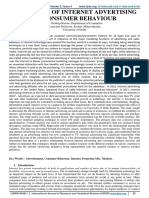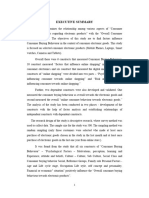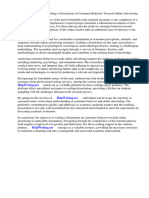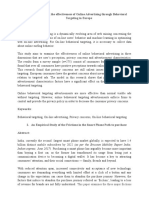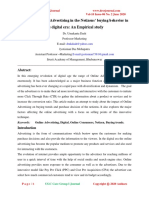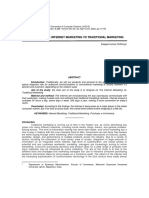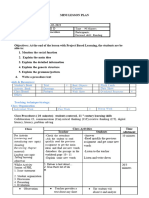A Descriptive Study of The Effectiveness of Internet Advertising On Consumer Buying Behavior in Nagpur City
A Descriptive Study of The Effectiveness of Internet Advertising On Consumer Buying Behavior in Nagpur City
Uploaded by
ankit raghavCopyright:
Available Formats
A Descriptive Study of The Effectiveness of Internet Advertising On Consumer Buying Behavior in Nagpur City
A Descriptive Study of The Effectiveness of Internet Advertising On Consumer Buying Behavior in Nagpur City
Uploaded by
ankit raghavOriginal Title
Copyright
Available Formats
Share this document
Did you find this document useful?
Is this content inappropriate?
Copyright:
Available Formats
A Descriptive Study of The Effectiveness of Internet Advertising On Consumer Buying Behavior in Nagpur City
A Descriptive Study of The Effectiveness of Internet Advertising On Consumer Buying Behavior in Nagpur City
Uploaded by
ankit raghavCopyright:
Available Formats
International Journal of Latest Engineering and Management Research (IJLEMR)
ISSN: 2455-4847
www.ijlemr.com || Volume 03 - Issue 05 || May 2018 || PP. 01-03
A Descriptive Study of the Effectiveness of Internet Advertising
on Consumer Buying Behavior in Nagpur City
Prof. Anupkumar Dhore
Faculty of Marketing Management
Dr. Snehal Godbole
Faculty of Marketing Management, International Business and Banking & Insurance
Abstract: The present research report emphases on studying the impact of internet advertising on consumer
buying behaviour, which raises the consumers' intentions towards the product and buying behaviours. The
purchasing behaviour is strongly influenced by the image of the product which is built by the advertisers.
Advertisers are expected to shift their focus and spend millions in internet advertising in the coming years than
TV, print ads and another traditional advertising media.Online shopping is a growing trend in India and the
numbers of both sellers and buyers are increasing daily by whopping percentages. India’s total online sales
figure is estimated to reach the US $100 billion by 2020. With the rapid growth in technology, the internet is
becoming an important one stop point for consumers in finding most of their needs. Be it communication,
entertainment, information search or shopping, internet serves as a panacea for all their requirements. According
to the global networking giant Cisco, Digital transformation will take India's internet users from 373 million (28
percent of population) in 2016 to 829 million (59 percent of the Indian population) in 2021. This clearly
demonstrates that India is growing fast and people are becoming habitual of using the Internet as the evolution
of human society, the improvement in Communication processes and Digital Convergence open up innovative
opportunities and challenges for Marketing. Subsequently, the Internet has moved ahead to play a significant
role in the Consumer Decision Making Process. Many consumers are online every day for their personal &
official work, but do they notice the ads, banners displayed on that webpage and most important thing is to
check what is their recall value. The current study investigated the impact of internet advertising on consumer
buying behaviour by conducting a survey.
Keywords: Internet, advertisement, internet advertising, consumer, buying behaviour
Introduction:
The greatest product or service in the world won't make money unless consumers know it exists, this is
why advertisement is considered so important. Advertising is a form of marketing communication used to
promote or sell various products or services. In Latin “advertere” means “to turn towards”. There are various
ways putting up an advertisement as per the audience to be addressed.
Internet advertising is a form of promotion that uses the Internet and World Wide Web for the
expressed purpose of delivering marketing messages to attract customers. Examples of online advertising
include contextual ads on search engine results pages, banner ads, Rich Media Ads, Social network advertising,
online classified advertising, advertising networks and e-mail marketing. Response to brand communication is
instantaneous, and conversion to business is very high. This is because in contrast to conventional forms of
interruptive advertising, the viewer has actually chosen to see the commercial.
The time when only top-notch businesses set sail on internet marketing has gone now. It is time to
explore the advantages of internet marketing! Now internet marketing is much more cost-effective, all-inclusive,
easy to handle, and just a tick of mouse can, without much of a stretch do a great part of the specialized work
that, once upon a time required outsourcing. This provides ascend to huge opportunities for the businesses to
enhance their sales through internet marketing in an efficacious fashion.
Consumer buying behavior is the sum total of a consumer's attitudes, preferences, intentions, and
decisions regarding the consumer's behavior in the marketplace when purchasing a product or service.
Researchers, businesses and marketers study consumer behavior to understand what influences a consumer’s
shopping preferences and selection of products and services. Multiple factors affect consumer behavior, among
them economic status, beliefs and values, polish, personality, age and education (Kotler, 2004). Findings
on consumer behavior are used to develop methods that will boost company performance and gross revenue
www.ijlemr.com 1 | Page
Electronic copy available at: https://ssrn.com/abstract=3341900
International Journal of Latest Engineering and Management Research (IJLEMR)
ISSN: 2455-4847
www.ijlemr.com || Volume 03 - Issue 05 || May 2018 || PP. 01-03
Literature Review:
Online advertising refers to the type of marketing strategy that involves the use of internet for
promotion of products by delivering the marketing messages to the larger consumers. It includes delivering ads
to internet users via websites, e-mail, ad supported software’s, text messaging and internet enabled cell phones.
The internet population is younger, more affluent, and better educated and they easily find their way onto the
internet, the cyberspace population is becoming more mainstream and diverse. In online marketing, it is the
consumer, not the marketer, who gives permission and controls the interaction. Internet consumers have around
the clock access to varied information sources, making them better informed and more discerning shoppers.
Awareness Trail Model of consumer response to advertisement (Ehrenberg,1974)
This review of theories postulate an Awareness-Trial-Reinforcement model of consumer response to
advertising and the main purpose of advertising for established brands is its defensive role in maintaining repeat
buyers. In answer to how ad works, one model that applies to certain advertising categories is "Advertising
offers a stimulus to a potential user of a product, which it is hoped will produce the response of an increased
predisposition to buy the advertised brand." This was a descriptive type of study. This study concludes that
advertisements displaying discount offers attract the netizen immediately followed by other features of the ads
like colors used in the ads and promotions provided on the online ads of the products.
Consumers have direct control over web based advertisements on what ads, when, where, and how long
they would like to see them (Gallagher et. al., 2001).
According to this literature on internet advertisements, it was concluded that voluntary and exposure ad
formats like banner and text ads are more likely to be cognitively avoided since it is an automatic, sub conscious
process that occurs in parallel with browsing activity and does not require any behavioural action by consumer.
This is a descriptive study. This literature concludes that in comparison to movable and immovable ads, netizen
prefer movable advertisements that include visuals, music, graphics and animations.
Theories of Advertising(Weilbacher,1984)
This review of theories in advertising suggests that there is no consensus about how consumers interact
with advertising or how these specific interactions do not lead to particular results in the market place This is a
descriptive study. The study concludes that internet advertising influenced purchase decision of the customers to
a moderate extent as only nearly half of the respondents were influenced purchase decision.
Problem of the study:
Internet is one of the important mediums that own all kinds of features, which implies a great potential
and powerful advertising medium in the future. In addition, Internet has a better impact than traditional media in
the features like format variety, affinity and storage. Furthermore, Internet is the only medium so far which
owns the feature of interactivity. Internet creates lots of new communication opportunities and possibilities that
were unable to be achieved in the past because of the limitation of media technologies. In spite of these whether
the online advertisement is effective in influencing the potential buyers in modern era is the key question that
the researcher is going to explore.
Objectives of the study:
1. To determine the effectiveness of internet advertising on reach and creation of awareness.
2. To determine the influence of internet advertising on consumer buying behaviour.
3. To determine the relationship between internet advertising and purchase decision.
Hypothesis:
H0 – A: A significant number of women get influenced by internet advertising more than men
H0 – B: Millennial/ Youngsters (30 years or below) get more influenced by Internet advertising than the Grown
up /Adults (30 years and above)
Research Methodology:
The study is based on secondary as well as primary data. The primary data was collected form the
respondents at Nagpur through a structured questionnaire. Any questionnaire which was incomplete was not
taken into consideration for the analysis. This study used descriptive research. Descriptive research involves
gathering data that describe events and then organizes, tabulates, depicts, and describes the data collection. It
www.ijlemr.com 2 | Page
Electronic copy available at: https://ssrn.com/abstract=3341900
International Journal of Latest Engineering and Management Research (IJLEMR)
ISSN: 2455-4847
www.ijlemr.com || Volume 03 - Issue 05 || May 2018 || PP. 01-03
often uses visual aids such as graphs and charts to aid the reader in understanding the data distribution and
therefore offered a better clarification on online advertising, and ultimately gives a clear picture on the
effectiveness and reliability of internet advertising and its relationship to purchase decision. The technique used
for primary data collection was simple random sampling method. Secondary data was collected form
Company’s profile, journals and various literature studies are important sources of secondary data.
Sampling Detail
1. Target population: The research study has focused on urban consumers of above 18 years of age. So that
they can recall the reasons, which affect their perception of Internet advertisements.
2. Sampling unit: In this study the sampling unit is individual consumer.
3. Sample size: 100 consumers.
4. Sampling method: The sample is selected by using cluster sampling method.
The study area was spread across Nagpur District and 100 samples were taken for the study of the topic.
This research studied the psychology behind online consumer’s behaviour and also their perception of Internet
advertisements
Limitations:
1. The study has confined to urban areas as it assumed that the rural areas do not have good Internet
connection and so the entire findings are based on urban consumers only
2. Geographical coverage, as only limited areas have been taken from Nagpur, India. It is not sure whether the
findings will apply to the whole country.
3. Respondents below 18 years of age were not included in the present study, as it was assumed that these
respondents can answer questions relating to Internet advertising. This is a limitation as respondents below
18 years also use the Internet and if they had been included in the sample; their opinion on issues relating to
Internet advertising may have given important insights.
Data Analysis
Table 4.1.1Gender distribution of the respondents
Frequency Percentage
Gender
Male 55 55 0%
Female
Female 45 45 45% Male
55%
Total 100 100.0 0%
Figure 4.1.1
According to table 4.1.1, the number of male respondents is more than the female respondents. The
number of male respondents is 55(55%), where female respondents are 45(45%). The total sample of the
respondents in this research is 100 people.
www.ijlemr.com 3 | Page
Electronic copy available at: https://ssrn.com/abstract=3341900
International Journal of Latest Engineering and Management Research (IJLEMR)
ISSN: 2455-4847
www.ijlemr.com || Volume 03 - Issue 05 || May 2018 || PP. 01-03
Table 4.1.2 Distribution of the respondents by age bracket
Age Bracket Frequency Percentage
3% Age Group
19-25 years 60 60
19-25 years 26-40 years
26-40 years 35 35 41-55 years Above 55
2%
41-55 years 3 3
35%
60%
Above 55 2 2
Total 100 100
Figure 4.1.2
Based on Table 4.1.2 and Figure 4.1.2 majority of the respondents are the age group between 19
and 25 years old which represent 60(60%) individuals of the whole sample size. The following groups fall
under the age group of below 19-25 (60.0%) and 26-40 (35%) years old with 35 people. There are 3 (3.0%)
respondents are under age group of 41-55 years old and above. Lastly, only 2 (2.0%) respondents are falls
under age group above 55 years old.
Table 4.1.3 Distribution of the respondents by hours spent on internet daily
Particulars Frequency Percentage (%)
Hours spent on internet daily
< 1hr 8 8
1hr to 2hrs 32 32 < 1hr 1hr to 2hrs 3hrs to 4hrs 4hrs to 5hrs >5hrs
15% 0% 0% 8%
3hrs to 4hrs 34 34
11% 32%
4hrs to 5hrs 11 11 34%
>5hrs 15 15
Total 100 100
Figure 4.1.3
The above graph shows how many hours spend by the consumer daily on internet. We can see that 34%
people spend around 4 hours on internet where as 32% people spent around 1hr to 2hr and 11% people spent 4hr
to 5hr respectively.
Table 4.2 Distribution of the respondents paying attention to Internet ads
Particulars Frequency Percentage (%)
Yes 65 64 Attention to Ads
No 35 36
Total 100 100 Yes No
0% 0%
36%
64%
Figure 4.2
www.ijlemr.com 4 | Page
Electronic copy available at: https://ssrn.com/abstract=3341900
International Journal of Latest Engineering and Management Research (IJLEMR)
ISSN: 2455-4847
www.ijlemr.com || Volume 03 - Issue 05 || May 2018 || PP. 01-03
The figure 4.2 shows that people pay attention on online advertisement. We can see that almost 65% people
pay attention on various Ads whereas only 35% don’t pay attention.
4.3 Effectiveness of internet advertising on reach and create awareness
The first objective of the study was to determine the effectiveness of internet advertising on reach and
creation of awareness. The study sought to establish whether the respondents were aware of various forms of
advertisements adopted by various companies. Majority of the respondents (34%) attested to being aware of
various forms of advertisements. This illustrates that the effectiveness of internet advertising on reach and
creation of awareness was determined by the level of knowledge about the existing platforms of advertisements.
The respondents were asked to indicate their attitude towards advertisements. Table 4.3 illustrates the study
findings.
Table 4.3 Attitude towards Advertisements
Particulars Frequency Percentage
Attitude
Informative 21 21
Attitude
Creates Awareness 35 35 35
21 25
Irritating 25 25 15
0 4
Entertaining 15 15
Waste of time 4 4
Total 100 100
Figure: 4.3
As shown in Table 4.3, most of the respondents (21%) indicated that advertising was informative,
with a closer percentage of 34 % indicating creation of awareness. 25% indicated that advertising was
irritating,. 15% indicated that advertising was entertaining. 4% indicated that advertising was a waste of time
These findings mean that most of the respondents had a positive attitude towards advertising as illustrated by
their various perceptions about the use of advertising. This clearly shows a positive attitude toward advertising
and hence is a good indication for marketers.
4.4 Influence of internet advertising on consumer buying behavior
The second objective of the study was to determine the influence of internet advertising on consumer
buying behaviour. Respondents were asked to indicate the of influence advertisement in buying behaviour. The
results were shown in pie chart 4.4
Table: 4.4 Influence of internet ads. on consumer buying behaviour
Influence Frequency Percentage (%)
Large Influence 16 16
Influence
Large Influence Medium INFLUENCE Not Sure
Medium Influence 53 53
0% 16%
Not Sure 31 31 31%
53%
Total 100 100
Figure 4.4
www.ijlemr.com 5 | Page
Electronic copy available at: https://ssrn.com/abstract=3341900
International Journal of Latest Engineering and Management Research (IJLEMR)
ISSN: 2455-4847
www.ijlemr.com || Volume 03 - Issue 05 || May 2018 || PP. 01-03
As shown in Table 4.4, most of the respondents 53% indicated that advertising was medium
influencing, with a closer percentage of 31 % indicated that advertising was largely influential. 16% of
respondents were not sure about the influence of advertising. These findings mean that most of the respondents
have considered internet advertisings are largely influencing in buying behaviours.
4.5 Relationship between internet and its usage.
The respondents were further asked to indicate their purpose of using internet. The study findings are
illustrated in table 4.5 and figure 4.5
Table 4.5 Internet Usage
Chatting and
Particulars Frequency Percentage
(%)
social
networking,
Internet Usage
50 Information,
Chatting and 45 45 45
45 35
social
networking 40
Email 11 11 35
30
Information 35 35 25
20
E-commerce 3 3 Email, 11
15 Downloading
E-
Downloading 6 6 10 ,6
5 commerce, 3
Total 100 100 0
Figure 4.5
As shown in Figure 4.5, 11% of the respondents used internet for E-mail, 35% for information, and
45% for chatting and social networking, indicating that communications has been the fundamental value of the
internet to consumers. There was a higher chance of interaction with various online ads through chatting and
social networking which influence consumer buying behaviours as reflected by the diverse usage of internet.
4.6 Reliability of internet advertising through recall
One of the objective of the study was to establish the reliability of internet advertising through recall.
First, the respondents were asked whether they would check an online advertisement and the findings presented
in the Table 4.6.
Table 4.6 checking an online advertisement
Checking an internet ads
Particulars Frequency Percentage 0%
0%
Yes 64 64 No
36%
Yes
No 36 36
64%
Total 100 100
Figure 4.6
www.ijlemr.com 6 | Page
Electronic copy available at: https://ssrn.com/abstract=3341900
International Journal of Latest Engineering and Management Research (IJLEMR)
ISSN: 2455-4847
www.ijlemr.com || Volume 03 - Issue 05 || May 2018 || PP. 01-03
In case of online advertising, majority 64% of consumers ignored the advert completely while 36%
indicated that they would check an online advert. Further the study found out that, out of the 36% respondents,
18% said that the intention was not to see the ads, but they didn’t have any option but to see them as they were
Interstitial. Adverts, Pop – up ads or Floating ads. These ads either block the view of the content, or appear right
in the middle of the page, or keeps on floating (moving) around which is considered to be very irritating for the
consumers. Checking the ads determined the level of interaction with the online ads. Therefore, even though the
reach of internet is much higher than that of other modes, its ability to attract consumers for awareness creation
is very low.
4.7 Relationship between internet advertising and purchase decision
The third objective of the study was to determine the relationship between internet advertising and
purchase decision. Respondents were asked to indicate the mode advertising that mostly influenced their
decision to purchase a product. The results were tabulated in Table 4.7
Table 4.7 Mode of advertising influencing intention to buy product
Particulars Frequency Percentage
(%)
Print ads 13 13
TV 33 33
Commercials
Online Ads 24 24
Social Media 30 30
Total 100 100
Mode of advertising influencing intention
to buy product
TV
40 Commercials, 33 Social Media, 30
30 Online Ads, 24
20 Print ads, 13
10
0
Print ads TV Online Ads Social Media
Commercials
Figure 4.7
Based on Table 4.7 above, 33% of the respondents were influenced to buy a product based on
information provided by TV commercials. Online advertisements were second in influencing their decision at
24 %. Therefore, TV commercials were the major influencers behind decision making. This depicts that
traditional form of advertising has an edge over internet advertising in terms of consumer preference to mode of
advertising.
Secondly, the respondents were also asked to indicate whether the internet ads they came across
influenced their purchase decision. 76% of the respondents indicated that the internet ads they came across
never influenced their purchase decision while 24% posited that the internet ads they came across influenced
www.ijlemr.com 7 | Page
Electronic copy available at: https://ssrn.com/abstract=3341900
International Journal of Latest Engineering and Management Research (IJLEMR)
ISSN: 2455-4847
www.ijlemr.com || Volume 03 - Issue 05 || May 2018 || PP. 01-03
their purchase decision. This depicts that the internet advertising influenced purchase decision of the customers
to a moderate extent as only nearly half of the respondents were influenced purchase decision.
4.8 Effectiveness of internet advertising in actual purchase decision
Table 4.8 Actual Purchase Decision made through internet advertisement
Particulars Frequency Percentage (%)
Actual Purchase Decision made
Yes 67 67 0% through Internet Advertisement 0%
No 33 33 No
33%
Yes
67%
Figure 4.8
Based on figure 4.8 above, 67% of the respondents were purchased a product based on information
provided by internet advertisements. 33% respondents were not influenced by internet advertising and didn’t
make any actual purchases after advertising. This indicates that internet advertising were the major influencers
behind purchase decision making
4.9 Repeated advertising affect consumer behaviour. This repetition serves as a reminder to a consumer.
In order to further determine the relationship between internet advertising and purchase decision, the
respondents were requested to indicate level of extent to which repeated internet ads serves as a reminder to
them which affect the buying behaviour.
Table 4.9 Repeated ads serves as a reminder to a consumer.
Particulars Frequency Percentage (%)
Repeated ads serves as a
To no extent 13 13
reminder to a consumer
To little extent 51 51
To no extent
To moderate 26 26
extent To little extent
To a great 10 10
extent
To moderate
Total 100 100 extent
To a great extent
Figure 4.9
Based on figure 4.9, 51% respondents were agreed that repeated advertising affect consumer behaviour
to little extent. , 26% respondents were agreed that repeated advertising affect consumer behaviour to moderate
extent. While 13% respondents were agreed that repeated advertising affect consumer behaviour to no extent.
This indicates that repeating advertising serves as a reminder to a consumer and affects buying behaviour.
Hypotheses Testing
H0 – A: A significant number of women get influenced by internet advertising more than men
www.ijlemr.com 8 | Page
Electronic copy available at: https://ssrn.com/abstract=3341900
International Journal of Latest Engineering and Management Research (IJLEMR)
ISSN: 2455-4847
www.ijlemr.com || Volume 03 - Issue 05 || May 2018 || PP. 01-03
Observed Frequency table:
Women Men Total
Influenced 24 23 47
Not Influenced 21 32 53
45 55 100
Expected frequency table
Women Men Total
Influenced 21.15 25.85 47
Not Influenced 23.85 29.15 53
45 55 100
Chi Square Statistics
Residual Component =
Observed Expected (Obs -
Response (Obs - (Obs - Exp)^2 /
Frequency Frequency Exp)^2
Exp) Exp
Influence Women 24 21.15 -2.85 8.1225 0.38
Influence Men 23 25.85 2.85 8.1225 0.31
Not Influence Women 21 23.85 2.85 8.1225 0.34
Not Influence Men 32 29.15 -2.85 8.1225 0.28
Chi-square Value 1.31
p-value at df = 1 [(2-1)x(2-1)] 0.25
To test the abovementioned hypothesis chi-square test of independence has been applied to check
whether impact of internet advertising is gender dominated. Hence, assumption was that variable “Women” is
independent of variable “Men”. On calculating the chi-square value, the result obtain are:
Chi-square = 1.31
P value at 5% level of significance at d.f. 1 = 0.25
There are conclusive evidences for not rejecting a null hypothesis. Thus we will accept the null hypothesis
that A significant number of women get influenced by internet advertising more than men
H0 – B: Millennial/ Youngsters (30 years or below) get more influenced by Internet advertising than the
Grown up /Adults (30 years and above)
Observed Frequency table:
Youngsters Grown up Total
Influenced 37 23 60
Not Influenced 21 19 40
58 42 100
Expected frequency table
Women Men Total
Influenced 34.8 25.2 60
Not Influenced 23.2 16.8 40
45 55 100
www.ijlemr.com 9 | Page
Electronic copy available at: https://ssrn.com/abstract=3341900
International Journal of Latest Engineering and Management Research (IJLEMR)
ISSN: 2455-4847
www.ijlemr.com || Volume 03 - Issue 05 || May 2018 || PP. 01-03
Chi Square Statistics
Component =
Observed Expected Residual
Response (Obs - Exp)^2 (Obs - Exp)^2 /
Frequency Frequency (Obs - Exp)
Exp
Influence Women 37 34.8 -2.2 4.84 0.14
Influence Men 23 25.2 2.2 4.84 0.19
Not Influence Women 21 23.2 2.2 4.84 0.21
Not Influence Men 19 16.8 -2.2 4.84 0.29
Chi-square Value 0.83
p-value at df = 1 [(2-1)x(2-1)] 0.36
To test the abovementioned hypothesis chi-square test of independence has been applied to check
whether impact of internet advertising is generation specific or dominated. Hence, assumption was that variable
“Youngsters” is independent of variable “Grown Up”. On calculating the chi-square value, the result obtain are:
Chi-square = 0.83
P value at 5% level of significance at d.f. 1 = 0.35
There are conclusive evidences for not rejecting a null hypothesis. Thus we will accept the null hypothesis
that Millennials/ Youngsters (30 years or below) get more influenced by Internet advertising than the
Grown up /Adults (30 years and above)
Recommendation and Conclusion:
As we come to the end of the study, this report provide an in depth and very comprehensive picture
oneffectiveness of internet advertising on consumer buying behavior in Nagpur city.Overall in a study on
effectiveness of internet advertising on consumer buying behaviour, the outcomes which came from the survey
which is conducted over the 100 number of people is as follows. In a research, the researchers found that the
Internet users (all age groups people) have the similar perception towards the internet advertisements.
The study established that the effectiveness of internet advertising on reach and creation of awareness
was determined by the level of knowledge about the existing platforms of advertisements. Most of the
respondents had a positive attitude towards advertising as illustrated by their various perceptions about the use
of advertising. This clearly shows a positive attitude toward advertising and hence is a good indication for
marketers. The findings augment that marketing is perceived by the internet users as a major source of
information on available product in the market as reflected by their positive attitude in the world over. Internet
advertising is an effective channel for marketing as the ad are attractive and appealing which changes from time
to time.
The study established that even though the reach of internet is much higher than that of other modes, its
ability to attract consumers for awareness creation is very low. The study concludes that the reliability of
internet advertising through recall was low as only a small percentage of the respondents could recall the online
ads they had seen.
The study established that internet advertising influenced purchase decision of the customers to a
moderate extent as only nearly half of the respondents were influenced purchase decision. The study established
that internet advertising is a key determinant of purchase decision of the customers. The study also established
that internet advertising has significant relationship with purchase decision of the consumers. The findings
augment that internet advertising is a key determinant of purchase decision by the customers and that internet
advertising has an association with purchase decision.
www.ijlemr.com 10 | Page
Electronic copy available at: https://ssrn.com/abstract=3341900
International Journal of Latest Engineering and Management Research (IJLEMR)
ISSN: 2455-4847
www.ijlemr.com || Volume 03 - Issue 05 || May 2018 || PP. 01-03
References:
[1]. Cook, Guy (2001 2nd edition) "The Discourse of Advertising", London: Routledge, ISBN 0-415-
23455-7
[2]. Graydon, Shari (2003) "Made You Look - How Advertising Works and Why You Should Know",
Toronto: Annick Press, ISBN 1-55037-814-7
[3]. Johnson, J. Douglas, "Advertising Today", Chicago: Science Research Associates, 1978. ISBN 0-574-
19355-3
[4]. Gibson, Mathias (12 July 2012). "History of Online Display Advertising". Vantage Local. Retrieved 23
June 2013.
[5]. Kuester, Sabine (2012): MKT 301: Strategic Marketing & Marketing in Specific Industry Contexts,
University of Mannheim, p. 110.
[6]. Lynn R. Kahle; Angeline G. Close (2011). Consumer Behavior Knowledge for Effective Sports and
Event Marketing. New York: Routledge. ISBN 978-0-415-87358-1.
[7]. Elizabeth A. Minton; Lynn R. Khale (2014). Belief Systems, Religion, and Behavioral Economics.
New York: Business Expert Press LLC. ISBN 978-1-60649-704-3.
[8]. J. Scott Armstrong (1991). "Prediction of Consumer Behavior by Experts and Novices" (PDF). Journal
of Consumer Research. Journal of Consumer Research Inc. 18: 251–256. doi:10.1086/209257.
[9]. Sandhusen, Richard L.: Marketing (2000). Cf. S. 218
[10]. Trochim, W.M.K, (2006). Research Methods Knowledge Base.
[11]. Shields, Patricia and Rangarjan, N. 2013. A Playbook for Research Methods
[12]. End Model and Synthesis of Evidence”. The Journal of Marketing, Vol. 52, No. 3 (Jul., 1988), pp. 2-22
[13]. BagirathiIyer, An Analytical Study Of Impact Of Marketing Strategies Of Company In Developing
Brand Name And Brand Acceptance Of Consumer Durable Goods With Special Reference To Nagpur
Region(From The Dealers Perspective), International Journal Of Research In Business Management,
Vol. 3, Issue 12, Dec 2015, 27-38
[14]. Yu-Jing Chiu, Hsiao-Chi Chen, Gwo-HshiungTzeng, Joseph Z. Shyu (Institute of Management of
Technology, National Chiao Tung University) “Marketing strategy based on customer behaviour for
LCD T.V”. International Journal of management and decision, Vol. 7, No.2-3\2006 (Pgs. 143-165).
[15]. Larry J. Rosenberg, John A. Czepiel, (1984), “A Marketing Approach For Customer Retention",
Journal of Consumer Marketing. Vol. 1 Iss: 2, pp.45 – 51
[16]. P.Kotler, G. Armstrong,” Customer driven Marketing Strategy,” in Principles of Marketing, 13th
Edition. Pearson Education Inc.2010,pp 160 to 170
[17]. M.Irfan, C. Sumangala, L. D’ Souza,” Green Marketing Mix Strategies of Consumer Durables with
reference to automobile sector”, International Journal Of Emerging Research in Management and
Technology, ISSN: 2278
[18]. lume -3, Issue -6), June 2014.
[19]. P. Yannopolous, “Impact of the Internet on Marketing strategy formulation”, International Journal of
Business & Social science, Vol.2 No.18; Oct 2011.
[20]. Nielson (2011) Nielson Global Online Consumer Confidence and Opinion Survey $Q-2010, The
Nielson & Co, USA
[21]. NMCC (2009) Assessment of the Comparative Advantage of Various Consumer Goods Produced in
India Vis-à-Vis their Chinese Counterparts
[22]. Rama B (2010) Drunken Man’s Wald, Business Standard, February 20, New Delhi
[23]. Bettis RA, Hitt Ma (1995), The New Competitive Landscape. The Strategic Management Journal16:7-
19
[24]. Hammer M (1997) Beyond the End of Management in R. Gibson (Ed.). Rethinking the future, Nicholas
Berry Publishing, London
[25]. Henderson, Pamela W, Joseph A. Cote (1998) Guidelines for Selecting or Modifying Logos. Journal of
Marketing. 62 (April) pp 14-30
[26]. Gralpois B (1998) Fighting the illusion of brand loyalty. Direct Marketing 61:5-62
[27]. Olshavsky N, Richard, Miller A, John (1972) Consumer Expectation, Product Performances, and
Perceived Product Quality. Journal of Marketing Research 19:19-21
[28]. Anderson E, Ralph (1973) Consumer Dissatisfaction: The Effect of Disconfirmed Expectancy on
Perceived Product Performance. Journal of Marketing Researcj1:38-44
[29]. Butz HE, Jr., Goodstein LD (1996) Measuring Customer Value: Gaining the Strategic Advantage.
Organizational Dynamics 24:63-77
[30]. Rogers E (1962) The diffusion of Innovations, New York : Free Press
www.ijlemr.com 11 | Page
Electronic copy available at: https://ssrn.com/abstract=3341900
International Journal of Latest Engineering and Management Research (IJLEMR)
ISSN: 2455-4847
www.ijlemr.com || Volume 03 - Issue 05 || May 2018 || PP. 01-03
[31]. Stoneman, P. (ed), (1995) Handbook of the economics of innovation and technological change, Oxford:
Blackwells
[32]. Deneckere RJ, De Plama (1998), The Diffusion of Consumer Durables in Vertically Differentiated
Oligopoly. Journal of Economics 29:750-771
[33]. Urde, Mats (1999) Brand Orientation: A mindset for Building Brands into Strategic Resources, Journal
of Marketing Management 15:117-133
[34]. Kotler Philip (2000) Marketing Management , The Millennium Edition, Upper Saddle River, Prentice
Hall
[35]. Aakar David A, Erich Joachimsthaler (2000) Brand Leadership, London, Free Press
[36]. Keller KL (2003) Strategic Brand Management, 2nd Edition, Upper Saddle River, NJ: Prentice Hall
[37]. Beskano D, Wilson W (1990) Optimal Pricing Skimming by a Monopolist Facing Rational Consumers.
Management Science 36:555-567
www.ijlemr.com 12 | Page
Electronic copy available at: https://ssrn.com/abstract=3341900
You might also like
- Lesson 9 - Current and Future Trends in Media and Info. TGDocument16 pagesLesson 9 - Current and Future Trends in Media and Info. TGEnan Garcia80% (5)
- PreambleDocument18 pagesPreambleJayrold Catandijan LertidoNo ratings yet
- Impact of Online Advertising On Consumers Buying Behaviour: A Study With Reference To Karkala TalukDocument5 pagesImpact of Online Advertising On Consumers Buying Behaviour: A Study With Reference To Karkala TalukAlliah .ThomasNo ratings yet
- To Study An Impact of Online Advertising On Consumer Buyung BehaviorDocument13 pagesTo Study An Impact of Online Advertising On Consumer Buyung Behaviornikita.mhatremms22-24No ratings yet
- 16 Ais 072Document7 pages16 Ais 072MD Hafizul Islam HafizNo ratings yet
- To Study Consumer Reaction and Perception Towards Online AdvertisemntDocument6 pagesTo Study Consumer Reaction and Perception Towards Online AdvertisemntMahendra BaidNo ratings yet
- ROLDocument4 pagesROLMrunal WaghchaureNo ratings yet
- CONSUMER ATTITUDE TOWARDS ONLINE ADVERTISEMENT - FlipkartDocument82 pagesCONSUMER ATTITUDE TOWARDS ONLINE ADVERTISEMENT - Flipkartssd technologiesNo ratings yet
- Impact of Online Advertising On Consumers Buying Behaviour: A Study With Reference To Karkala TalukDocument5 pagesImpact of Online Advertising On Consumers Buying Behaviour: A Study With Reference To Karkala TalukJaem HuangNo ratings yet
- Impact of Online Advertising On Consumers Buying Behaviour: A Study With Reference To Karkala TalukDocument5 pagesImpact of Online Advertising On Consumers Buying Behaviour: A Study With Reference To Karkala TalukbobNo ratings yet
- Online Marketing and Consumer Purchase Behaviour On Fashion StoresDocument8 pagesOnline Marketing and Consumer Purchase Behaviour On Fashion StoresAemon Saleem 2015-2117No ratings yet
- Abstract 2Document15 pagesAbstract 2Singh's CreationsNo ratings yet
- Effects of Online Marketing On The Behaviour of Consumers in Selected Online Companies in Owerri, Imo State - NigeriaDocument12 pagesEffects of Online Marketing On The Behaviour of Consumers in Selected Online Companies in Owerri, Imo State - Nigeriainventionjournals100% (1)
- IJRAR1904811Document12 pagesIJRAR1904811parasmalhotracnbknpNo ratings yet
- 2nd ChapterDocument27 pages2nd ChapterJustin JoseNo ratings yet
- Abs GMDocument44 pagesAbs GMvivekNo ratings yet
- Online Marketing ThesisDocument32 pagesOnline Marketing ThesisMichaelAngeloBattung100% (2)
- JETIR2403175Document17 pagesJETIR2403175mèj · ̊ ༘No ratings yet
- Group7 RMB Project ReportDocument29 pagesGroup7 RMB Project ReportChittrieta GorainNo ratings yet
- RRL With SYNTHESISDocument5 pagesRRL With SYNTHESISSALLAN JEROME J.No ratings yet
- 04 - Chapter 1Document41 pages04 - Chapter 1wwq468789No ratings yet
- Research ProposalDocument11 pagesResearch Proposaltarun1133100% (2)
- Artificial Intelligence and Digital Marketing Role in Increasing Consumer Purchase IntentionDocument6 pagesArtificial Intelligence and Digital Marketing Role in Increasing Consumer Purchase IntentionaijbmNo ratings yet
- Dissertation Report On Consumer Behavior Towards Online AdvertisingDocument5 pagesDissertation Report On Consumer Behavior Towards Online AdvertisingHelpInWritingPaperIrvineNo ratings yet
- The Effectiveness of Internet Advertising On Consumer BehaviourDocument9 pagesThe Effectiveness of Internet Advertising On Consumer BehaviourshahabNo ratings yet
- Abstract - MarketingDocument3 pagesAbstract - MarketingArpita SrivastavaNo ratings yet
- Hassan Rahmat IkeoluwaDocument15 pagesHassan Rahmat IkeoluwaTunbosunNo ratings yet
- Internet Marketing Literature Review PDFDocument5 pagesInternet Marketing Literature Review PDFafmzbdjmjocdtm100% (1)
- IJIRSTV2I10099 With Cover Page v2Document8 pagesIJIRSTV2I10099 With Cover Page v2Sohil MakadiaNo ratings yet
- Group 2 Chapters 1-5 (Revised)Document48 pagesGroup 2 Chapters 1-5 (Revised)Renz LephoenixNo ratings yet
- Impact of Online Advertising in The Netizens' Buying Behavior in The Digital Era: An Empirical StudyDocument15 pagesImpact of Online Advertising in The Netizens' Buying Behavior in The Digital Era: An Empirical Studysfgoe wksdfNo ratings yet
- Analysis of Advertising Intensity On Consumer Consumtive BehaviorDocument9 pagesAnalysis of Advertising Intensity On Consumer Consumtive BehaviorFatawil AkbarNo ratings yet
- Conceptual FrameworkDocument22 pagesConceptual FrameworkJaem HuangNo ratings yet
- MRP SynopsisDocument3 pagesMRP Synopsissamn98No ratings yet
- Effect of Advertisement On Consumer BehaDocument8 pagesEffect of Advertisement On Consumer BehaRahul YadavNo ratings yet
- A Study On Consumer Behaviour Towards Digital Marketing in Ramanathapuram DistrictDocument7 pagesA Study On Consumer Behaviour Towards Digital Marketing in Ramanathapuram DistrictJanelle De VeasNo ratings yet
- Consumer Behaviour Towards E-Marketing: A Study of Jaipur ConsumersDocument12 pagesConsumer Behaviour Towards E-Marketing: A Study of Jaipur ConsumersArun PrasaathNo ratings yet
- INSPIRA JOURNAL OF COMMERCEECONOMICS COMPUTER SCIENCEJCECS Vol 8 No 2 April June 2022 Pages 01 To 08 PDFDocument8 pagesINSPIRA JOURNAL OF COMMERCEECONOMICS COMPUTER SCIENCEJCECS Vol 8 No 2 April June 2022 Pages 01 To 08 PDFHimanshu GhaddinkarNo ratings yet
- Final Report AdvertisingDocument115 pagesFinal Report Advertising8217553593mysNo ratings yet
- Mba Research Project ReportDocument40 pagesMba Research Project Reportdivyanshya03No ratings yet
- Impact of Online Advertising On ConsumersDocument5 pagesImpact of Online Advertising On ConsumersPiumi SuloshanaNo ratings yet
- Adiba KhanDocument35 pagesAdiba Khansayuraparveen1234No ratings yet
- The Impact of Online Marketing On CustomDocument156 pagesThe Impact of Online Marketing On CustomEzatullah Siddiqi100% (2)
- Internet Advertising and Consumer Behavior in The Purchase of ProductsDocument8 pagesInternet Advertising and Consumer Behavior in The Purchase of Productsdindo_waeNo ratings yet
- Consumer Behaviour Term PaperDocument5 pagesConsumer Behaviour Term PaperShashikant MishraNo ratings yet
- Internet Advertising and Consumer Behavior in The Purchase of ProductsDocument8 pagesInternet Advertising and Consumer Behavior in The Purchase of Productsmira swaniNo ratings yet
- 14 Chapter 5Document8 pages14 Chapter 5Gowtham SmileyNo ratings yet
- IJRPR4450Document7 pagesIJRPR4450EmoEkambaramNo ratings yet
- The Impact of Online Advertisement On Consumers' Buying BehaviorDocument7 pagesThe Impact of Online Advertisement On Consumers' Buying BehaviorNikshep AntonyNo ratings yet
- 1.1 Background To The StudyDocument43 pages1.1 Background To The StudyPregina MichaelNo ratings yet
- OnlineadandbuyersDocument9 pagesOnlineadandbuyersPravin KhuneNo ratings yet
- Unta Sure Na. GramarianDocument97 pagesUnta Sure Na. GramarianCris Mae Aperdo AmparadoNo ratings yet
- Influence of Advertisements On Consumer Behavior: A Study of Graduate and Postgraduate StudentsDocument12 pagesInfluence of Advertisements On Consumer Behavior: A Study of Graduate and Postgraduate Studentsshresthanikhil078No ratings yet
- Online Advertisment Consumer Buying BehaviourDocument9 pagesOnline Advertisment Consumer Buying BehaviourarzoNo ratings yet
- Paper 11 PDFDocument12 pagesPaper 11 PDFDebasmita MahanandNo ratings yet
- 7MG001 Milestone 1Document10 pages7MG001 Milestone 1Nadia RiazNo ratings yet
- Technical Seminar Report Edii LOHITHDocument19 pagesTechnical Seminar Report Edii LOHITHakash45ak7No ratings yet
- Omkar Sawant ResearchDocument9 pagesOmkar Sawant ResearchOmkar SawantNo ratings yet
- Literature review WoolworthsDocument11 pagesLiterature review WoolworthsSujan AryalNo ratings yet
- Culture and Tourism: A Study of SikkimDocument136 pagesCulture and Tourism: A Study of Sikkimankit raghavNo ratings yet
- Case Analysis January PLPDocument4 pagesCase Analysis January PLPankit raghavNo ratings yet
- Personal Development Plan: PLP and CDP Exercises For The Month of December, 2020Document4 pagesPersonal Development Plan: PLP and CDP Exercises For The Month of December, 2020ankit raghavNo ratings yet
- CocacolaDocument20 pagesCocacolaankit raghavNo ratings yet
- O-Ring Groove DesignDocument31 pagesO-Ring Groove DesignduuckNo ratings yet
- Read The Following Text To Answer Questions Number 1 and 2Document4 pagesRead The Following Text To Answer Questions Number 1 and 2chefa foreverNo ratings yet
- Talapaksaan: Lit 3: Maikling Kuwento at Nobelang Filipino College VisionDocument9 pagesTalapaksaan: Lit 3: Maikling Kuwento at Nobelang Filipino College VisionAnaliza SantosNo ratings yet
- Pges 18 and 19Document2 pagesPges 18 and 19CatyNo ratings yet
- 100 Tu Kho Hay Gap Pte ReadingDocument15 pages100 Tu Kho Hay Gap Pte Readingtho NguyenNo ratings yet
- A Critical Analysis On India's Internet ShutdownsDocument11 pagesA Critical Analysis On India's Internet ShutdownsAnanthu SureshNo ratings yet
- 2024 RAM 1500 TowingDocument7 pages2024 RAM 1500 Towingdavid.contatos4308No ratings yet
- Katalog HPL Taco 2020Document55 pagesKatalog HPL Taco 2020Dika RizkyNo ratings yet
- TerminationDocument21 pagesTerminationkunal_kapoor404100% (1)
- Case NoteDocument4 pagesCase NoteAbhilash Reddy60% (5)
- Dvorak Chamber MusicDocument196 pagesDvorak Chamber Musicchircu100% (5)
- Test 16: Choose The Best Option To Complete The Following SentencesDocument4 pagesTest 16: Choose The Best Option To Complete The Following SentencesTong Quỳnh AnhNo ratings yet
- Hobbes Studies Volume 25 Issue 1 2012 Krasnoff, Larry - Voluntarism and Conventionalism in Hobbes and KantDocument23 pagesHobbes Studies Volume 25 Issue 1 2012 Krasnoff, Larry - Voluntarism and Conventionalism in Hobbes and KantAndrés Cisneros SolariNo ratings yet
- Baroque and Rococo Architecture NotesDocument4 pagesBaroque and Rococo Architecture NotesElton100% (1)
- Vision 250 E/It: VintenDocument71 pagesVision 250 E/It: VintenTudor PirvuNo ratings yet
- Leson PlanDocument3 pagesLeson PlanA2 Dps Ni Wayan riki cahyaniNo ratings yet
- Kingdom of Bretonnia - ArmyDocument3 pagesKingdom of Bretonnia - Armybedewi4458No ratings yet
- 1-Alliance For Automotive Innovation Letter On Federal Privacy LegislationDocument2 pages1-Alliance For Automotive Innovation Letter On Federal Privacy LegislationBrandon ChewNo ratings yet
- 019 - Harrod Last Five Eprs RedactedDocument10 pages019 - Harrod Last Five Eprs Redactedapi-317210322No ratings yet
- Padilla V Padilla 74 Phil 377Document5 pagesPadilla V Padilla 74 Phil 377Charmaine MejiaNo ratings yet
- Business and Professional Writing Course SyllabusDocument10 pagesBusiness and Professional Writing Course SyllabusBonjovi HajanNo ratings yet
- Articles of Association and Its AlterationDocument4 pagesArticles of Association and Its AlterationSahil BainslaNo ratings yet
- MODULE 10-B - EARLY CHILDHOOD ADocument14 pagesMODULE 10-B - EARLY CHILDHOOD AKaren GimenaNo ratings yet
- 5 Axe HH Anglais VioletDocument29 pages5 Axe HH Anglais Violetyoyo mumbaNo ratings yet
- Manuscrito Nva Rosita Coah 2019Document23 pagesManuscrito Nva Rosita Coah 2019alexandraNo ratings yet
- Day Tour Abu Dhabi PDFDocument6 pagesDay Tour Abu Dhabi PDFNorthstar Safety Systemz Pvt. Ltd.No ratings yet
- Summary of Teaching Load FINAL 2022 Qualification UPDATEDDocument10 pagesSummary of Teaching Load FINAL 2022 Qualification UPDATEDRegine ManuelNo ratings yet
- Planning Simulink Model Architecture and Modeling Patterns For Iso 26262 ComplianceDocument21 pagesPlanning Simulink Model Architecture and Modeling Patterns For Iso 26262 Compliancesaurabh anandNo ratings yet













